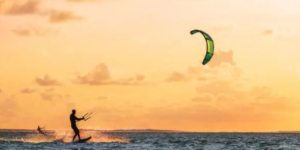Kitesurfing is a fast-evolving sport with some difficult risks to anticipate or control, making kiting an exciting yet safe activity. Therefore, it is vital that participants fully comprehend these potential dangers and take necessary precautions for an enjoyable kiting experience.
Your kite boarding instructor will show you how to navigate a kite on land before performing water exercises like body dragging before allowing you to ride on board.
Wind Conditions
 Wind conditions are essential when kite boarding; considering wind direction, power, and flight window must all be considered for an enjoyable and safe kiteboarding experience.
Wind conditions are essential when kite boarding; considering wind direction, power, and flight window must all be considered for an enjoyable and safe kiteboarding experience.
Wind speeds of 10 knots (12 mph or higher are considered optimal. Depending on their characteristics, lighter and heavier kites may need more or less wind.
As offshore winds can be hazardous for kiters in the event of equipment failure or loss of control, kiters should avoid riding in these conditions. Also, avoid cross-offshore wind conditions, which may quickly blow you out to sea, making it harder for you to return when needed.
Keep an eye out for wind conditions and observe other kiters to understand the average power level that fits your skill level. Beginners may benefit from beginning on flat water or with no more than 2ft waves until their confidence and skills improve enough to ride three ft+ waves.
Equipment
Kiteboarding is an exhilarating, entertaining activity that can be done virtually anywhere with enough wind to keep the kite flying – beaches, lakes, oceans and even snow! (known as Snow kiting).
Equipment required to kitesurf consists of a kite, lines, control bar and harness. Kites come in different sizes, but all have the same purpose: flying in the sky above water.
Various riding styles are available today, such as freeride, wake style, wave riding, jumping and toe-side. Combined, they allow riders to create unique tricks on water or air.
Kite boarding equipment is relatively lightweight and can easily fit in the trunk of your car. Additionally, wetsuits, personal flotation devices, board leashes, line cutters and signalling devices may all prove invaluable – not to mention having access to a pump to inflate your kite correctly before getting out onto the water!
Safety
Kitesurfing requires several safety measures that must be considered, starting with making sure the wind conditions meet your skill level and providing ample room to ride without obstacles or people nearby. Furthermore, creating an additional safety measure by creating an adequate buffer between you and other kiters should also be considered.
Before jumping, you must consider all possible directions, as traffic conditions in the area could change between when you take off and when you land. Furthermore, be conscious of your surroundings – for example, avoiding rocks or obstacles that could derail you!
Getting Started
Kiteboarding is an intense, entertaining sport that offers great creative freedom when performing stunts and tricks, attracting athletes of all backgrounds to take up this form of kite surfing.
At first, working with an instructor will allow you to learn to fly and control a kite safely while being shown how to enter and exit the water safely. You will also become acquainted with its components, including bar, lines, harness, and board – although learning these things takes time, it will come naturally, and progress will quickly occur.
Once you’ve become proficient at body dragging and have enough confidence in the water to try your first board, your instructor will assist in getting up onto it using kite power to ride along its surface. As it propels forward, you will experience its energy as though breaking away from Earth’s gravitational pull temporarily.
The Board
The kitesurfer’s board is a key factor in a safe and enjoyable ride. The shape, rail and fins impact how the board performs. Some riders like to have multiple boards of different sizes to be able to choose the right one for each day.
The biggest risk is being dragged (or lofted) from behind a power kite. It can lead to injuries or even death when colliding with hard objects like water, buildings, terrain, and power lines.
